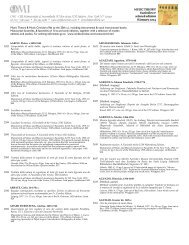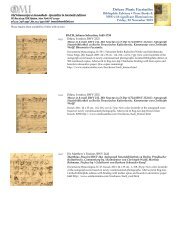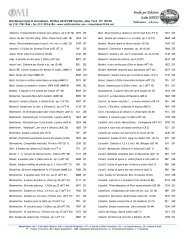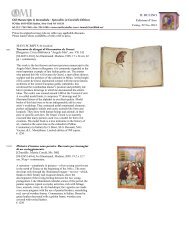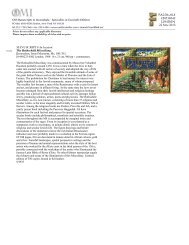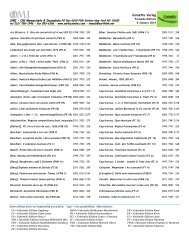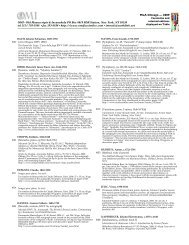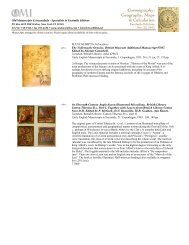Bibles & sacred texts - facsimiles - Omi
Bibles & sacred texts - facsimiles - Omi
Bibles & sacred texts - facsimiles - Omi
You also want an ePaper? Increase the reach of your titles
YUMPU automatically turns print PDFs into web optimized ePapers that Google loves.
OMI - Old Manuscripts & Incunabula • tel 212/ 758-1946 • fax 593-6186 • www.omi<strong>facsimiles</strong>.com • immels@earthlink.net Biblical <strong>texts</strong>, p.34<br />
15th c. La bibbia di Borso d’Este.<br />
[Modena, Bibl. Estense Univ., lat. 422 & 423]<br />
Modena, 1998. 28 x 40 cm. 2 vols, 1212 pp; 2 vols, 851 pp (commentary).<br />
The Bible made for Borso d'Este, duke of Ferrara, between 1455 and 1461 is a masterpiece<br />
of Italian renaissance miniaturist work. For the first time in this codex book illustration<br />
reflects the new language of the Renaissance, giving a more rational interpretation to the<br />
fantastic elaborations of late-gothic art. The most celebrated artists of the period worked on<br />
the bible, to create a work of enduring beauty, ensuring the legacy of the splendid Este<br />
court and the munificence of Duke Borso. The miniaturists, the most noted being Taddeo<br />
Crivelli and Franco dei Russi, painted each page both recto and verso, illustrating episodes<br />
from the Old and New Testaments. Biblical events are reinterpreted in the elegant spirit of<br />
the Este court reflected in the costume, refined style and aristocratic bearing of the figures.<br />
The formal language bears witness to the advances in perspective which originated in<br />
Tuscany combined with the meticulous realistic attention to detail typical of Flemish<br />
painting. The Bible is also rich in both colored and gold decorative elements, with friezes<br />
inhabited by mythological and zoomorphic creatures, painted white sculptures and Este<br />
emblems. These combine to create an extraordinary gallery of renaissance art, alone of all<br />
its kind. Commentary by Vincenzo Cappelletti, Ernesto Milano, Gianni Venturi,<br />
Gianfranco Ravasi, Federica Toniolo, & Mariani Canova. Limited edition 750 copies,<br />
bound in crimson velvet over wood, with silver-gilt medallions on the front plate, two<br />
silver-gilt straps and clasps.<br />
15th c. Die Ottheinrich Bibel.<br />
[Munich, Bayerische Staatsbibliothek, cgm 8010/1.2]<br />
Luzern, 2002. 37.2 x 53.2 cm, 156 pp + commentary.<br />
Around the year 1425 an anonymous member of the Court commissioned one the finest<br />
German Bible manuscripts in Regensburg. From the 10th century the illuminators’<br />
workshops in Regensburg inspired the schools in the Danube region, where monasteries<br />
specialized in illustrated luxury mss. Thanks to Ottheinrich, the bibliophile Elector Palatine<br />
(1502-1559) who bought the manuscript c.1530 as a showpiece for his prestigious<br />
Biblioteca Palatina, this magnificient work of art and monument to the German language<br />
has been saved. Ottheinrich hired the Renaissance master Matthias Gerung to continue the<br />
decoration of the manuscript and the artist made it into the sumptuous and unequaled<br />
edition of the New Testament that we know today. In total 8 volumes containing the new<br />
Testament in German comes down to us. MS cgm 8010/1.2 reproduced here (the first 2<br />
volumes of the Ottheinrich Bible), encompasses the Gospels of St. Matthew and St. Mark<br />
as well as portions of the Gospel of St. Luke. Its importance among the masterpieces of<br />
German art cannot be overstated; the Bible is also of the greatest interest in the history of<br />
the German language since it was written at a time when Luther’s translation of the New<br />
Testament was still 100 years in the future. The Bible is lavishly illustrated with sparkling<br />
gold and precious colors. The two principal masters are from the school of the leading<br />
Regensburgian artist of this period—”Master of the Carrying of the Cross of<br />
Worcester”—and are named “Master of St. Matthew” and “Master of St. Mark”. The<br />
miniatures of the Master of St. Matthew recall the style of Giotto; his color palette<br />
comprises violet and grey tones to underline the modelling of the figures. The Master of St.<br />
Mark also follows the Italian models; a talented storyteller he tries to animate the scenes<br />
depicted by enlargement and imaginative drama. Although sharing a common stylistic<br />
background both artists developed an individual painting technique to utmost perfection.<br />
Commentary by Robert Suckale, Jeffrey Hamburger, Brigitte Gullath & Karin Schneider.<br />
Limited edition of 980 copies, with binding featuring gold and blind tooling, 8 bosses and 4<br />
clasps; front cover shows Ottheinrich's in gold tooling, the back cover his coat of arms.



